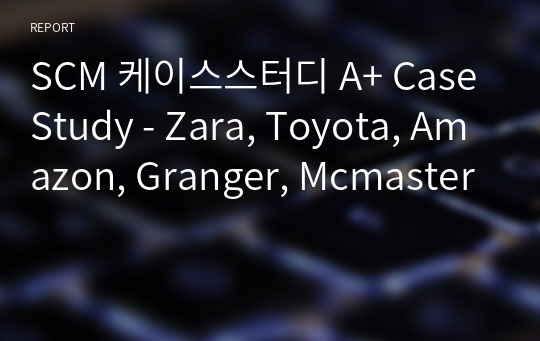SCM 케이스스터디 A+ Case Study - Zara, Toyota, Amazon, Granger, Mcmaster
Realsalmon
다운로드
장바구니
소개글
"SCM 케이스스터디 A+ Case Study - Zara, Toyota, Amazon, Granger, Mcmaster"에 대한 내용입니다.목차
Ⅰ. Examples of Supply Chains – Gateway1. Why did Gateway have multiple production facilities in the US? What advantages or disadvantages does this strategy offer relative to Dell, which has one facility?
2. What factors did Gateway consider when deciding which plants to close?
3. Why does Gateway not carry any finished goods inventory at its retail stores?
4. Should a firm with an investment in retail stores carry any finished goods inventory? Characteristics of products for finished-goods inventory?
5. Is the Dell model of selling directly without any retail stores always less expensive than a supply chain with retail stores?
6. What are the supply chain implications of Gateway’s decision to offer fewer configurations?
Ⅱ. Examples of Supply Chains – Zara
1. What advantage does Zara gain against the competition by having a very responsive supply chain?
2. Why has Inditex chosen to have both in-house manufacturing and outsourced manufacturing?
3. Why does Zara source products with uncertain demand from local manufacturers?
4. What advantage does Zara gain from replenishing its stores multiple times a week compared to a less frequent schedule? How does the frequency of replenishment affect the design of its distribution system?
5. What information infrastructure does Zara need in order to operate its production, distribution, and retail network effectively?
Ⅲ. Examples of Supply Chains – Grainger
1. How many DCs should there be built and where should they be located?
2. How should product stocking be managed at the DCs? Should all DCs carry all products?
3. What products should be carried in inventory and what products should be left at the supplier?
4. What products should Grainger carry at a store?
5. How should markets be allocated to DCs? What should be done if an order cannot be completely filled from a DC?
6. How should replenishment of inventory be managed at various stocking locations?
7. How should Web orders be handled relative to the existing business? Integrated or separate operations?
8. What transportation modes should be used for order and stock?
Ⅳ. Examples of Supply Chains – Toyota
1. Where should plants be located, what degree of flexibility should each have, and what capacity should each have?
2. Should plants be able to produce for all markets or only specific contingency markets?
3. How should markets be allocated to plants and how frequently should this allocation be revised?
4. What kind of flexibility should be built into the distribution system?
5. How should this flexible investment be valued?
6. What actions may be taken during product design to facilitate this flexibility?
Ⅴ. Examples of Supply Chains – Amazon
1. Why is Amazon building more warehouses as it grows? How many warehouses should it have and where should they be located?
2. What advantages does selling books via the Internet provide over traditional bookstore? Are there any disadvantages?
3. Should Amazon stock every book it sells?
4. What advantages can bricks-and mortar players derive from setting up an online channel? How should they use the two channels to gain maximum advantage?
5. Should traditional booksellers integrate e-commerce into their current supply chain or manage it as a separate supply chain?
6. For what products does the e-commerce channel offer the greatest advantages? What characterizes these products?
참고 문헌
본문내용
Ⅰ. Examples of Supply Chains – Gateway1.
Gateway사는 미국 전역에 약 280개의 소매점을 두는 공격적인 전략을 채택했다. 이와 동시에 소매점에 완제품 재고를 두지 않고, 그저 모델로 있는 제품을 시험해볼 수 있게 만들어 놨는데, 이는 고객들이 원하는 성능의 컴퓨터를 주문제작 가능하게 만들었다. 이 전략은 주문이 확정되면 그 때 제품을 조립하여 운반하게 함으로써 불필요한 완제품의 재고 운반비용을 줄일 수 있었다. 반면 Dell은 facility수를 줄이고 중개 업체를 사용하지 않고 직접 판매함으로써 컴퓨터의 제공 단가를 크게 낮출 수 있었다.
전통적인 소매점은 1. 면대면 교환 2. 고객이 직접 제품 픽업 3. 시설이 고객과 가까움 4. 재고 수준의 높음 5. 낮은 아웃바운드 수송비용의 특징을 가지고 있다. 특징 중에서는 장점도 존재하고 단점도 존재한다. 이 장점을 최대한 훼손하지 않는 선에서 단점을 보완할 수 있는 옴니채널 포트폴리오가 중요한 것이다. 옴니채널로써 온라인매장+홈 딜리버리 시스템을 설계하게 된다면 재고의 통합 효과/많이 필요하지 않은 Facility의 수/높은 수송비용 등의 특징을 함께 가져갈 수 있을 것이고, 온라인매장+고객직접픽업 시스템을 설계하게 된다면 아웃바운드 수송비용의 감축/고객이 무조건 직접 픽업해야하는 번거로움 등의 특징을 갖게 된다.
<중 략>
Ⅱ. Examples of Supply Chains – Zara
1.
자라가 추구하는 Responsiveness전략은 빠르게 전환되는 생산 사이클과 효율적인 분배가 주가 되는 시스템이다. 자라의 의류디자인은 1~2주에 한 번씩 트렌드에 맞게 개발된다. 이는 다른 기업이 새 디자인을 내놓는 평균인 6개월에 비해 수치적으로 약 12배나 빠른 대응이다. 따라서 자라는 1년에 약 10,000종의 새로운 디자인을 내놓을 수 있다는 것을 뜻한다. 다른 기업들이 이제 막 트렌드를 따라 제품을 생산하기 시작할 때, 자라는 이미 공급까지 끝마친 상태인 것이다.
참고 자료
JK, Liker, JK,“Toyota Way and Supply Chain Management”, 2005, 미시간 대학교 OESA Lean to Survive Program 프레젠테이션JK, Liker, JK, "Toyota Way : 세계 최대 제조업체의 14 가지 관리 원칙", 2005, McGraw-Hill Companies
L.Krajewski, M. Ritzman, N.Malhotra, 운영 관리 : 프로세스 및 가치 사슬. (제 8 판), 2006, 프렌 티스 홀
Sabio Bernard, “Supply Chain Management of TOYOTA”, 2013, https://www.slideshare.net/sabiobernard/supply-chain-management-of-toyotacase-study-by-sabio-bernard
S. Chopra and P. Meindl & R. Ballou, “Supply Chain Management”, 2013, Pearson
김진현, “델 SCM 사례분석 성공요인”, 2012, https://sirano21.tistory.com/9



























